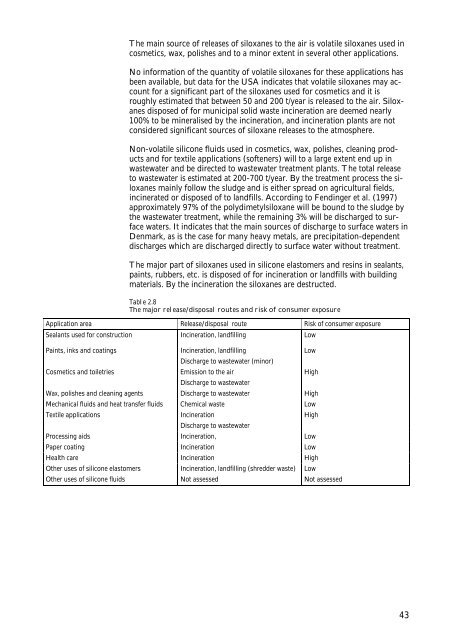No. 1031 - Miljøstyrelsen
No. 1031 - Miljøstyrelsen
No. 1031 - Miljøstyrelsen
You also want an ePaper? Increase the reach of your titles
YUMPU automatically turns print PDFs into web optimized ePapers that Google loves.
The main source of releases of siloxanes to the air is volatile siloxanes used in<br />
cosmetics, wax, polishes and to a minor extent in several other applications.<br />
<strong>No</strong> information of the quantity of volatile siloxanes for these applications has<br />
been available, but data for the USA indicates that volatile siloxanes may account<br />
for a significant part of the siloxanes used for cosmetics and it is<br />
roughly estimated that between 50 and 200 t/year is released to the air. Siloxanes<br />
disposed of for municipal solid waste incineration are deemed nearly<br />
100% to be mineralised by the incineration, and incineration plants are not<br />
considered significant sources of siloxane releases to the atmosphere.<br />
<strong>No</strong>n-volatile silicone fluids used in cosmetics, wax, polishes, cleaning products<br />
and for textile applications (softeners) will to a large extent end up in<br />
wastewater and be directed to wastewater treatment plants. The total release<br />
to wastewater is estimated at 200-700 t/year. By the treatment process the siloxanes<br />
mainly follow the sludge and is either spread on agricultural fields,<br />
incinerated or disposed of to landfills. According to Fendinger et al. (1997)<br />
approximately 97% of the polydimetylsiloxane will be bound to the sludge by<br />
the wastewater treatment, while the remaining 3% will be discharged to surface<br />
waters. It indicates that the main sources of discharge to surface waters in<br />
Denmark, as is the case for many heavy metals, are precipitation-dependent<br />
discharges which are discharged directly to surface water without treatment.<br />
The major part of siloxanes used in silicone elastomers and resins in sealants,<br />
paints, rubbers, etc. is disposed of for incineration or landfills with building<br />
materials. By the incineration the siloxanes are destructed.<br />
Table 2.8<br />
The major release/disposal routes and risk of consumer exposure<br />
Application area Release/disposal route Risk of consumer exposure<br />
Sealants used for construction Incineration, landfilling Low<br />
Paints, inks and coatings Incineration, landfilling<br />
Discharge to wastewater (minor)<br />
Cosmetics and toiletries Emission to the air<br />
Discharge to wastewater<br />
Low<br />
High<br />
Wax, polishes and cleaning agents Discharge to wastewater High<br />
Mechanical fluids and heat transfer fluids Chemical waste Low<br />
Textile applications Incineration<br />
Discharge to wastewater<br />
Processing aids Incineration, Low<br />
Paper coating Incineration Low<br />
High<br />
Health care Incineration High<br />
Other uses of silicone elastomers Incineration, landfilling (shredder waste) Low<br />
Other uses of silicone fluids <strong>No</strong>t assessed <strong>No</strong>t assessed<br />
43

















